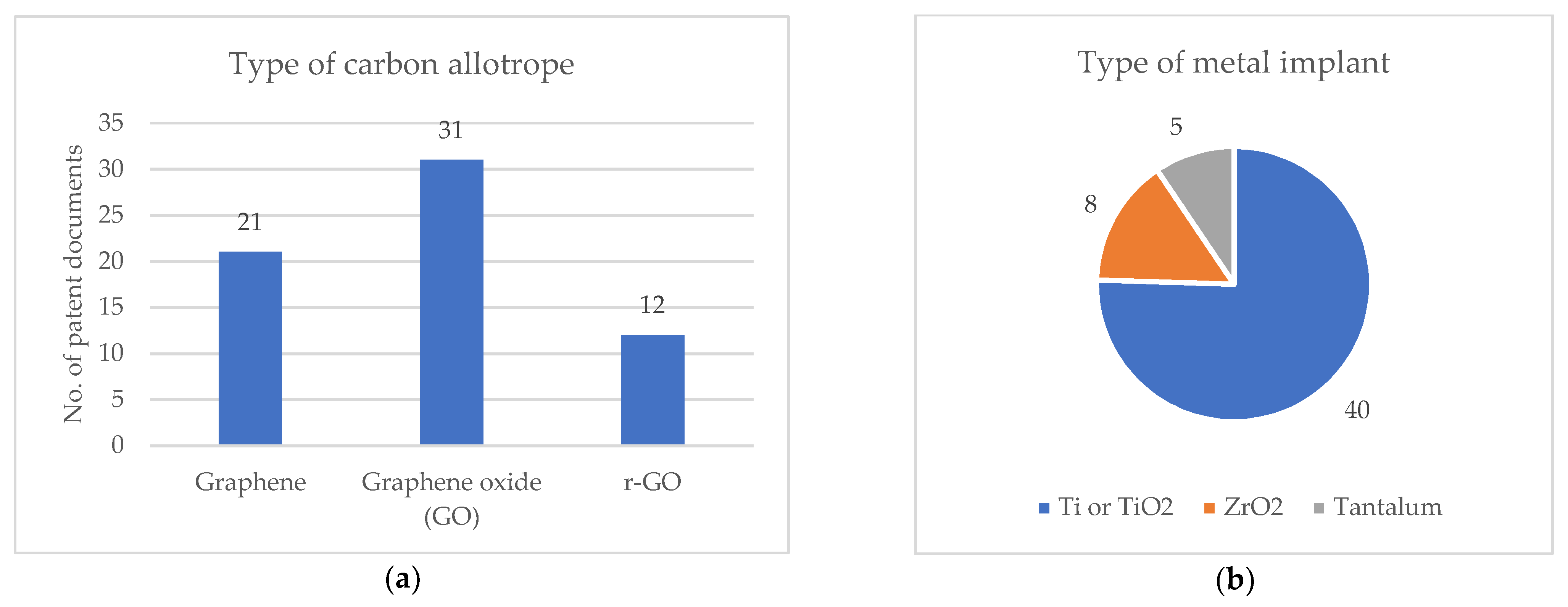Graphene and Its Derivatives in Dental Implants: A Patent Landscape Study †
Abstract
1. Introduction
2. Materials and Methods
- The identification of potential investment opportunities;
- The determination of research and development (R&D) priorities;
- The assessment of competitor activities;
- The assessment of the freedom to operate in introducing new products to the market.
- By keywords (an intuitive but subjective approach);
- By classification codes or citations (language-independent tools).
3. Results and Discussion
4. Conclusions
Funding
Institutional Review Board Statement
Informed Consent Statement
Data Availability Statement
Conflicts of Interest
References
- Shin, Y.C.; Bae, J.-H.; Lee, J.H.; Raja, I.S.; Kang, M.S.; Kim, B.; Hong, S.W.; Huh, J.-B.; Han, D.-W. Enhanced osseointegration of dental implants with reduced graphene oxide coating. Biomater. Res. 2022, 26, 11. [Google Scholar] [CrossRef] [PubMed]
- Mobarak, H.; Hossain, N.; Hossain, A.; Mim, J.J.; Khan, F.; Rayhan, T.; Islam, A.; Chowdhury, M.A. Advances of graphene nanoparticles in dental implant applications—A review. Appl. Surf. Sci. Adv. 2023, 18, 100470. [Google Scholar] [CrossRef]
- Inchingolo, F.; Inchingolo, A.M.; Latini, G.; Palmieri, G.; Di Pede, C.; Trilli, I.; Ferrante, L.; Inchingolo, A.D.; Palermo, A.; Lorusso, F.; et al. Application of Graphene Oxide in Oral Surgery: A Systematic Review. Materials 2023, 16, 6293. [Google Scholar] [CrossRef] [PubMed]
- Inchingolo, A.M.; Malcangi, G.; Inchingolo, A.D.; Mancini, A.; Palmieri, G.; Di Pede, C.; Piras, F.; Inchingolo, F.; Dipalma, G.; Patano, A. Potential of Graphene-Functionalized Titanium Surfaces for Dental Implantology: Systematic Review. Coatings 2023, 13, 725. [Google Scholar] [CrossRef]
- Kim, W.J.; Cho, Y.-D.; Ku, Y.; Ryoo, H.-M. The worldwide patent landscape of dental implant technology. Biomater. Res. 2022, 26, 1–14. [Google Scholar] [CrossRef] [PubMed]
- Cho, Y.-D.; Kim, W.-J.; Ryoo, H.-M.; Ku, Y. Patent landscape report on dental implants: A technical analysis. Clin. Implant. Dent. Relat. Res. 2021, 23, 857–863. [Google Scholar] [CrossRef] [PubMed]
- Chang, S.W.; Trappey, C.V.; Trappey, A.J.; Wu, S.C. Forecasting Dental Implant Technologies Using Patent Analysis. In Proceedings of the PICMET ’14: Infrastructures and Service Integration, Kanazawa, Japan, 27–31 July 2014; pp. 1483–1490. [Google Scholar]
- Aristodemou, L.; Tietze, F. Citations as a measure of technological impact: A review of forward citation-based measures. World Pat. Inf. 2018, 53, 39–44. [Google Scholar] [CrossRef]
- Asche, G. “80% of technical information found only in patents”—Is there proof of this? World Pat. Inf. 2017, 48, 16–28. [Google Scholar] [CrossRef]
- Espacenet Patent Search. Available online: https://worldwide.espacenet.com (accessed on 21 June 2024).
- Espacenet Classification Search. Available online: https://worldwide.espacenet.com/patent/cpc-browser (accessed on 21 June 2024).
- IPCCAT Search. Available online: https://ipcpub.wipo.int/?notion=search&version=20240101&symbol=none&menulang=en&lang=en&viewmode=f&fipcpc=no&showdeleted=yes&indexes=no&headings=yes¬es=yes&direction=o2n&initial=A&cwid=none&tree=no&searchmode=ipccat (accessed on 21 June 2024).
- IPCCAT Web Service User Manual. Available online: https://www.wipo.int (accessed on 22 August 2024).
- Orbit Intelligence. Available online: https://orbit.com (accessed on 21 June 2024).
- Bokobza, L. On the Use of Nanoparticles in Dental Implants. Materials 2024, 17, 3191. [Google Scholar] [CrossRef] [PubMed]
- Williams, A.G.; Moore, E.; Thomas, A.; Johnson, J.A. Graphene-Based Materials in Dental Applications: Antibacterial, Biocompatible, and Bone Regenerative Properties. Int. J. Biomater. 2023, 2023, 8803283. [Google Scholar] [CrossRef] [PubMed]
- Ge, Z.; Yang, L.; Xiao, F.; Wu, Y.; Yu, T.; Chen, J.; Lin, J.; Zhang, Y. Graphene Family Nanomaterials: Properties and Potential Applications in Dentistry. Int. J. Biomat. 2018, 2018, 1539678. [Google Scholar] [CrossRef] [PubMed]
- Gurunathan, S.; Kim, Y.H. Synthesis, toxicity, biocompatibility, and biomedical applications of graphene and graphene-related materials. Int. J. Nanomed. 2016, 11, 1927–1945. [Google Scholar] [CrossRef] [PubMed]
- Arenas-Blanco, B.A.; Cepeda-Marín, G.R.; Cabanzo-Hernández, R.; Mejía-Ospino, E. Study of the water-oil interfacial activity of amino-modified graphene oxide. Colloids Surf. A Physicochem. Eng. Asp. 2022, 647, 129034. [Google Scholar] [CrossRef]
- Nizami, M.Z.I.; Takashiba, S.; Nishina, Y. Graphene Oxide: A new direction in dentistry. Appl. Mater. Today 2020, 19, 100576. [Google Scholar] [CrossRef]
- Rayannavar, S.; Mv, S.K.; Bembalgi, M.; Shankargouda, S.; Acharya, A.; Doddamani, M.; Hiremath, V.; A Shah, M. Evaluation of Osteoconductive and Antimicrobial Properties of Novel Graphene on Dental Implants: An In Vitro Study. Cureus 2024, 16, e54172. [Google Scholar] [CrossRef] [PubMed]




| Classification Code | Classification System | Definition |
|---|---|---|
| A61C8/00 | IPC/CPC | Means to be fixed to the jawbone for consolidating natural teeth or for fixing dental prostheses thereon; dental implants; implanting tools |
| A61C13/00 | IPC/CPC | Dental prostheses |
| C01B32/15 | IPC/CPC | Nano-sized carbon materials |
| C01B32/182 | IPC/CPC | Graphene |
| C01B2204/00 | CPC | Structure or properties of graphene |
| C01B32/198 | IPC/CPC | Graphene oxide (GO) |
| C08K3/042 | CPC | Uses of inorganic substances as compounding ingredients—graphene or derivatives |
| B82Y * | IPC/CPC | Specific uses or application of nanostructures |
| C04B35/46 | IPC/CPC | Ceramic products based on titanium oxides |
| C04B35/48 | Ceramic products based on zirconium or hafnium | |
| A61L37 * | IPC/CPC | Materials for prosthesis or for coating prosthesis |
Disclaimer/Publisher’s Note: The statements, opinions and data contained in all publications are solely those of the individual author(s) and contributor(s) and not of MDPI and/or the editor(s). MDPI and/or the editor(s) disclaim responsibility for any injury to people or property resulting from any ideas, methods, instructions or products referred to in the content. |
© 2024 by the author. Licensee MDPI, Basel, Switzerland. This article is an open access article distributed under the terms and conditions of the Creative Commons Attribution (CC BY) license (https://creativecommons.org/licenses/by/4.0/).
Share and Cite
Barbieri, M. Graphene and Its Derivatives in Dental Implants: A Patent Landscape Study. Mater. Proc. 2024, 19, 2. https://doi.org/10.3390/materproc2024019002
Barbieri M. Graphene and Its Derivatives in Dental Implants: A Patent Landscape Study. Materials Proceedings. 2024; 19(1):2. https://doi.org/10.3390/materproc2024019002
Chicago/Turabian StyleBarbieri, Massimo. 2024. "Graphene and Its Derivatives in Dental Implants: A Patent Landscape Study" Materials Proceedings 19, no. 1: 2. https://doi.org/10.3390/materproc2024019002
APA StyleBarbieri, M. (2024). Graphene and Its Derivatives in Dental Implants: A Patent Landscape Study. Materials Proceedings, 19(1), 2. https://doi.org/10.3390/materproc2024019002






